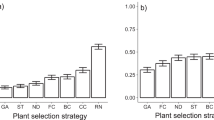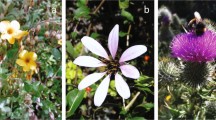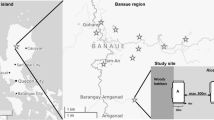Abstract
One of the ways to evaluate the success of restoration strategies in degraded areas, in terms of restoring pollination, key process for the reproduction of most angiosperm species, is evaluating species traits, how they respond to changes in the environment and influence their interacting partners. In this study we asked: (i) does the phenological variation, the restoration strategy and the restoration age influence species richness, abundance, species composition and distribution of traits of bees and plants? (ii) do functionally similar species tend to interact with the same mutualistic partners? (iii) what are the most important traits that explain the similarity of interacting partners? We analyzed bee and plant communities in restored areas in the Atlantic Forest. We found that bee richness and abundance did not vary, and plant richness varied temporally. Bee and plant composition changed over time and among restoration strategies. Plant composition also varied with the restoration age. Functional composition, especially of bees, varied little among the tested factors. We also found that species with similar traits tended to interact with similar partners, and bee size, proboscis length and nesting sites were the most important traits to explain the interactions, while for plants, the most important traits were form of life, corolla color and shape. Our study demonstrated that interactions between bees and plants can be mediated by plant phenology and, considering that plant traits filter pollinators’ traits, the choice of plant traits in restoration areas is fundamental for interactions.

Similar content being viewed by others
Data Availability
The authors confirm that the data supporting the conclusions of this study are available in the article and its supplementary materials.
References
Agostini K, Lopes AV, Machado IC (2014) Recursos e atrativos. In: Rech AR, Agostini K, Oliveira PE, Machado IC (eds) Biologia da Polinização, 1st edn. Projeto Cultural, Rio de Janeiro, pp 129–150
Aide TM, Zimmerman JK, Pascarella JB, Rivera L, Marcano-Vega H (2000) Forest regeneration in a chronosequence of tropical abandoned pastures: implications for restoration ecology. Restor Ecol 8:328–338. https://doi.org/10.1046/j.1526-100x.2000.80048.x
Arroyo-Rodríguez V et al (2017) Multiple successional pathways in human-modified tropical landscapes: new insights from forest succession, forest fragmentation and landscape ecology research. Biol Rev 92:326–340. https://doi.org/10.1111/brv.12231
Bartomeus I, Ascher JS, Gibbs J, Danforth BN, Wagner DL, Hedtke SM, Winfree R (2013) Historical changes in northeastern US bee pollinators related to shared ecological traits. PNAS 110:4656–4660. https://doi.org/10.5061/dryad.0nj49
Boscolo D et al (2023) Atlantic flower-invertebrate interactions: a data set of occurrence and frequency of floral visits. Ecology 104(3):e3900. https://doi.org/10.1002/ecy.3900
Cariveau DP, Nayak GK, Bartomeus I, Zientek J, Ascher JS, Gibbs J, Winfree R (2016) The allometry of bee proboscis length and its uses in ecology. PLoS ONE 11:1–13. https://doi.org/10.1371/journal.pone.0151482
Chazdon R (2012) Regeneração de florestas tropicais. Boletim Do Museu Paraense Emílio Goeldi Ciências Naturais 7:195–218. https://doi.org/10.46357/bcnaturais.v7i3.587
Cheung KC, Marques MCM, Liebsch D (2009) Relação entre a presença de vegetação herbácea e a regeneração natural de espécies lenhosas em pastagens abandonadas na floresta ombrófila densa do sul do Brasil. Acta Bot Bras 23:1048–1056. https://doi.org/10.1590/S0102-33062009000400015
Dafni A (1992) Pollination Ecology. Oxford University Press, Oxford, A practical approach series
Devoto M, Bailey S, Craz P, Memmott J (2012) Understanding and planning ecological restoration of plant-pollinator networks. Ecol Lett 15:319–328. https://doi.org/10.1111/j.1461-0248.2012.01740.x
Endress PK (1994) Diversity and evolutionary biology of tropical flowers, 1st edn. Cambridge University Press, New York
Faegri K, Pijl LVD (1971) Principles of pollination ecology, 2nd edn. Pergamon Press, Oxford
Ferretti AR, Britez RM (2006) Ecological restoration, carbon sequestration and biodiversity conservation: the experience of the Society for Wildlife Research and Environmental Education (SPVS) in the Atlantic rain forest of southern Brazil. J Nat Conser 14:249–259. https://doi.org/10.1016/j.jnc.2006.04.006
Fontaine C, Dajoz I, Meriguet J, Loreau M (2006) Functional diversity of plant-pollinator interaction webs enhances the persistence of plant communities. PLoS Biol 4:0129–0135. https://doi.org/10.1371/journal.pbio.0040001
Forrest JRK, Thorp RW, Kremen C, Williams NM (2015) Contrasting patterns in species and functional-trait diversity of bee in agricultural landscape. J of Appl Ecol 52:706–715. https://doi.org/10.1111/1365-2664.12433
Freitas L, Sazima M (2006) Pollination biology in a tropical high-altitude grassland in Brazil: interactions at the community level. BioOne 93:465–516. https://doi.org/10.3417/0026-6493(2007)93[465:PBIATH]2.0.CO;2
Garcia LC, Cianciaruso MV, Ribeiro DB, Santos FAM, Rodrigues RR (2015) Flower functional traits responses to restoration time. Appl Veg Sci 18:402–412. https://doi.org/10.1111/avsc.12163
Gathmann A, Tscharntke T (2002) Foraging ranges of solitary bees. J of Animal Ecol 71:757–764. https://doi.org/10.1046/j.1365-2656.2002.00641.x
Girão LC, Lopes AV, Tabarelli M, Bruna EM (2007) Changes in tree reproductive traits reduce functional diversity in a fragmented Atlantic forest landscape. PLoS ONE 9:1–12. https://doi.org/10.1371/journal.pone.0000908
Goslee SC, Urban DL (2007) The ecodist package for dissimilarity-based analysis of ecological data. J Stat Softw 22:1–19. https://doi.org/10.18637/jss.v022.i07
Goulson D (1999) Foraging strategies of insects for gathering nectar and pollen, and implications for plant ecology and evolution. Perspect Plant Ecol Evol Syst 2:185–209. https://doi.org/10.1078/1433-8319-00070
Gower JC (1971) A general coefficient of similarity and some of its properties. Biometrics 27:857–871. https://doi.org/10.2307/2528823
Greenleaf SS, Williams NM, Winfree R, Kremen C (2007) Bee foraging ranges and their relationship to body size. Oecologia 153:589–596. https://doi.org/10.1007/s00442-007-0752-9
IBGE (1992) Manual Técnico da Vegetação Brasileira. Fundação Instituto Brasileiro de Geografia e Estatística, Rio de Janeiro
IPARDES (2001) Zoneamento da Área de Proteção Ambiental de Guaraqueçaba. IPARDES, Curitiba
Kauano EE, Cardoso FCG, Torezan JMD, Marques MCM (2013) Micro-and meso-scale factors affect the restoration of Atlantic Forest. Nat Conserv 11:145–151. https://doi.org/10.4322/natcon.2013.023
Kauano EE, Torezan JMD, Cardoso FCG, Marques MCM (2012) Landscape structure in the northern coast of Paraná state, a hotspot for the Brazilian Atlantic forest conservation. Rev Árvore 36:961–970. https://doi.org/10.1590/S0100-67622012000500018
Kaiser-Bunbury CN, Traveset A, Hansen DM (2010) Conservation and restoration of plant animal mutualisms on oceanic islands. Perspect Plant Ecol Evol Sys 12:131–143. https://doi.org/10.1016/j.ppees.2009.10.002
Loiseau N, Legras G, Kulbick M, Mérigot B, Harmelin-Vivien M, Mazouni N, Galzin R, Gaertner JC (2016) Multi-component β-diversity approach reveals conservation dilemma between species and functions of coral reef fishes. J Biogeog 44:537–547. https://doi.org/10.1111/jbi.12844
Martins R, Antonini Y (2016) Can pollination syndromes indicate ecological restoration success in tropical forests? Restor Ecol 24:373–380. https://doi.org/10.1111/rec.12324
Michener CD (2007) Bees of the World, 2nd edn. University Press, Baltimore
Montoya-Pfeiffer PM, Rodrigues RR, Metzger JP, Silva CI, Baquero OS, Santos IA (2018) Are the assemblages of tree pollination modes being recovered by tropical forest restoration? Appl Veg Sci 21:156–163. https://doi.org/10.1111/avsc.12335
Montoya-Pfeiffer PM, Rodrigues RR, Santos IA (2020) Bee pollinator functional responses and functional effects in restored tropical forests. Ecol Appl 30(3):1–14. https://doi.org/10.1002/eap.2054
Morellato LPC et al (2000) Phenology of Atlantic rain forest trees: a comparative study. Biotropica 32:811–823. https://doi.org/10.1111/j.1744-7429.2000.tb00620.x
Moretti M, Bello F, Roberts SPM, Potts SG (2009) Taxonomical vs. functional responses of bee communities to fire in two contrasting climatic regions. J of Animal Ecol 78:98–108. https://doi.org/10.1111/j.1365-2656.2008.01462.x
Myers N, Mittermeier RA, Mittermeier CG, Fonseca GAB, Kent J (2000) Biodiversity hotspots for conservation priorities. Nature 403:853–858
Oksanen J et al (2017) Community Ecology Package. R package version 2.4–4. https://cran.ism.ac.jp/web/packages/vegan/vegan.pdf. Accessed 10 November 2017.
Oliveira RE, Engel VL (2017) Indicadores de monitoramento da restauração na Floresta Atlântica e atributos para ecossistemas restaurados. Scientia Plena 13:1–13. https://doi.org/10.14808/sci.plena.2017.127301
Oliveira PE, Gibbs PE (2000) Reproductive biology of woody plants in a cerrado community of central Brazil. Flora 195:311–329. https://doi.org/10.1016/S0367-2530(17)30990-8
Otárola MF, Rocca MA (2014) Flores no tempo: a floração como uma fase da fenologia reprodutiva. In: Rech AR, Agostini K, Oliveira PE, Machado IC (eds) Biologia da Polinização, 1st edn. Projeto Cultural, Rio de Janeiro, pp 113–126
Pinheiro M et al (2014) Polinização por abelhas. In: Rech AR, Agostini K, Oliveira PE, Machado IC (eds) Biologia da Polinização, 1st edn. Projeto Cultural, Rio de Janeiro, pp 205–233
Potts SG, Vulliamy B, Dafni A, Ne’eman G, Willmer P (2003) Linking bees and flowers: how do floral communities structure pollinator communities? Ecology 84:2628–2642. https://doi.org/10.1890/02-0136
R Development Core Team (2023) R: A Language and Environment for Statistical Computing. Austria, Vienna
Ramírez SR, Hernandéz C, Link A, López-Uribe MM (2015) Seasonal cycles, phylogenetic assembly, and functional diversity of orchid bee communities. Ecol Evol 5:1896–1907. https://doi.org/10.1002/ece3.1466
Ribeiro MC, Metzger JP, Martensen AC, Ponzoni FJ, Hirota MM (2009) The Brazilian Atlantic forest: how much is left, and how is the remaining forest distributed? Implications for conservation. Biol Cons 142:1141–1153. https://doi.org/10.1016/j.biocon.2009.02.021
Rodrigues RR, Lima RAF, Gandolfi S, Nave AG (2009) On the restoration of high diversity forests: 30 years of experience in the Brazilian Atlantic forest. Biol Conservation 142:1242–1251. https://doi.org/10.1016/j.biocon.2008.12.008
Rodrigues RR, Gandolfi S, Nave AG, Aronson J, Barreto TE, Vidal CY, Brancalion PHS (2011) Large-scale ecological restoration of high-diversity tropical forests in SE Brazil. For Ecol Manage 261:1605–1613. https://doi.org/10.1016/j.foreco.2010.07.005
Romanowski LL, Zanata TB, Marques MCM, Carlucci MB, Varassin IG (2021) Increased reproductive trait diversity, evolutionary history and distinctiveness during the succession of tropical forest. J Veg Sci 32:1–14. https://doi.org/10.1111/jvs.13090
Roubik DW (1989) Ecology and natural history of tropical bees. Cambridge University Press, Cambridge
Samnegard U, Hambäck PA, Eardley C, Nemomissa S, Hylander K (2015) Turnover in bee species composition and functional traits distributions between seasons in a tropical agricultural landscapes. Agric Ecosyst Environ 211:185–194. https://doi.org/10.1016/j.agee.2015.06.010
Sargent RD, Ackerly DD (2008) Plant-pollinator interactions and the assembly of plant communities. Trends in Ecol and Evol 23:123–130. https://doi.org/10.1016/j.tree.2007.11.003
Silveira FA, Melo GAR, Almeida EAB (2002) Abelhas brasileiras: sistemática e identificação, 1st edn. Authors edition, Belo Horizonte
Souza JMT, Vázquez DP, Varassin IG (2022) Abundance and phenology drive plant–pollinator network responses to restoration in the southern Atlantic rainforest in Brazil. Restor Ecol 30:1–11. https://doi.org/10.1111/rec.13588
Sydenham MAK, Moe SR, Stanescu-Yadav DN, Totland Ø, Eldegard K (2016) The effects of habitat management on the species, phylogenetic and functional diversity of bees are modified by the environmental context. Ecol and Evol 6:961–973. https://doi.org/10.1002/ece3.1963
Varassin IG, Amaral-Neto LP (2014) Atrativos. In: Rech AR, Agostini K, Oliveira PE, Machado IC (eds) Biologia da Polinização, 1st edn. Projeto Cultural, Rio de Janeiro, pp 150–168
Viana BF, Silva FO, Kleinert AMP (2001) Diversidade e sazonalidade de abelhas solitárias (Hymenoptera: Apoidea) em dunas litorâneas no Nordeste do Brasil. Neotrop Entomol 30:245–251. https://doi.org/10.1590/S1519-566X2001000200006
Warring B, Cardoso FCG, Marques MCM, Varassin IG (2016) Functional diversity of reproductive traits increases across succession in Atlantic forest. Rodriguésia 67:321–333. https://doi.org/10.1590/2175-7860201667204
Wilcock C, Neiland R (2002) Pollination failure in plants: why it happens and when it matters. Trends in Plant Sci 7:270–277. https://doi.org/10.1016/S1360-1385(02)02258-6
Williams NM (2011) Restoration of nontarget species: bee communities and pollination function in riparian forests. Restor Ecol 19:450–459. https://doi.org/10.1111/j.1526-100x.2010.00707.x
Williams NM, Crone EE, Roulston TH, Minckley RL, Packer L, Potts SG (2010) Ecological and life-history traits predict bee species responses to environmental disturbances. Biol Conserv 143:2280–2291. https://doi.org/10.1016/j.biocon.2010.03.024
Winfree R, Bartomeus I, Cariveau DP (2011) Native pollinators in anthropogenic habitats. Annu Rev Ecol Evol Syst 42:1–22. https://doi.org/10.1146/annurev-ecolsys-102710-145042
Winsa M, Öckinger E, Bommarco R, Lindborg R, Roberts SPM, Wärnsberg J, Bartomeus I (2017) Sustained functional composition of pollinators in restored pastures despite slow functional restoration of plants. Ecol and Evol 7:3836–3846. https://doi.org/10.1002/ece3.2924
Wojcik VA, Frankie GW, Thorp RW, Hernandez JL (2008) Seasonality in bees and their floral resource plants at a constructed urban bee habitat in Berkeley, California. Journal of the Kansas Entomological Society, Kansas 81:15–28. https://doi.org/10.2317/JKES-701.17.1
Acknowledgements
The authors appreciate Vinicius Marcilio da Silva and Gabriel A.R. Melo for suggestions in earlier drafts of the manuscript; Bruna L. Dering for her help with the map; Cassiana Bittencourt for her assistance in editing the English-language revision of this paper; the Society for Wildlife Research and Environmental Education for access to the study sites and logistical support; the Conselho Nacional de Desenvolvimento Científico e Tecnológico and the Coordenação de Aperfeiçoamento de Pessoal de Nível Superior for the funding. Assistance with identification of specimens was kindly provided by O. Guimarães, R. Goldenberg, O. Ribas, C. Snak, F. Meyer, J. Meirelles, M. Borgo, and P. G. Delprete (plants); G. A. R. Melo, B. Garcete-Barrett, M. Hermes, and D. Urban (Hymenoptera).
Author information
Authors and Affiliations
Corresponding author
Ethics declarations
Conflict of interest
This research was supported by Ministério da Ciência, Tecnologia e Inovação, Conselho Nacional de Desenvolvimento Científico e Tecnológico—CT-Agronegócio/ CT-Hidro (grant 577,336/2008 8), Coordenação de Aperfeiçoamento de Pessoal de Nível Superior, Brazil (Finance code 001 to CR) and Conselho Nacional de Desenvolvimento Científico e Tecnológico (grants 475,127/2008–0, and 312,580/2020–7 to IGV). The authors have no competing interests to declare that are relevant to the content of this article. The authors confirm that the data supporting the findings of this study are available within the article and its supplementary materials.
Additional information
Handling Editor: Isabel Alves dos Santos.
Publisher's Note
Springer Nature remains neutral with regard to jurisdictional claims in published maps and institutional affiliations.
Supplementary Information
Below is the link to the electronic supplementary material.
Rights and permissions
Springer Nature or its licensor (e.g. a society or other partner) holds exclusive rights to this article under a publishing agreement with the author(s) or other rightsholder(s); author self-archiving of the accepted manuscript version of this article is solely governed by the terms of such publishing agreement and applicable law.
About this article
Cite this article
Ribeiro, C., Varassin, I.G., Pagioro, T.A. et al. Bee and plant traits drive temporal similarity of pollination interactions in areas under distinct restoration strategies. Arthropod-Plant Interactions (2024). https://doi.org/10.1007/s11829-024-10064-7
Received:
Accepted:
Published:
DOI: https://doi.org/10.1007/s11829-024-10064-7




